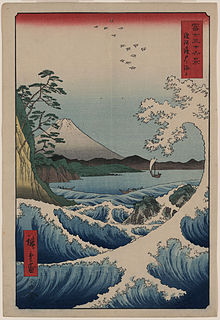Suruga Bay
This article needs additional citations for verification. (November 2012) |

Suruga Bay (駿河湾, Suruga-wan) is a bay on the
Geology
Suruga Bay is a place of contrasts. Japan's loftiest peak,

The bay is open to the Philippine Sea/Pacific Ocean to the south, but is mostly protected from oceanic waves by Izu Peninsula. This, coupled with the seabed and water characteristics mentioned above, results in conditions favorable to fishing, sailing, windsurfing, swimming, and research on deep-sea organisms.[3]
Suruga Bay was formed by
Environmental pollution
Ever since the post-war industrial boom of Japan, the bay has suffered from severe industrial pollution. By 1970, local paper mills produced so much that the small city of Fuji (1970 pop. 180,000) produced 2.4 million short tons (2.2 Mt) of waste water every day – equivalent to the daily sewage of Tokyo at the time (1970 pop. 9 million). The sulphur-laden sludge was so thick that it threatened to block the harbour, requiring dredging that severely damaged the marine life. Protests from local citizens and fishermen in the area put pressure on the government to take action.[6] Despite subsequent regulations, surveys of local sea life in the mid-2010s continue to show intense PCB and PBDE contamination.[7]
The pollution of Suruga Bay became so infamous that it featured in the 1971 film Godzilla vs. Hedorah. The name of the titular monster is derived from hedoro, the Japanese word for 'mud', and the creature fed off heavy pollution in the bay.
Transport
Suruga Bay can be reached by car from Tokyo via Numazu in two to five hours depending on traffic conditions on the Tōmei Expressway or in Numazu.
References
- ^ "静岡県/駿河湾早わかりガイド". www.pref.shizuoka.jp. Retrieved 2021-07-26.
- ^ 第2版, 日本大百科全書(ニッポニカ),デジタル大辞泉,ブリタニカ国際大百科事典 小項目事典,百科事典マイペディア,精選版 日本国語大辞典,世界大百科事典. "駿河湾とは". コトバンク (in Japanese). Retrieved 2021-07-26.
{{cite web}}: CS1 maint: multiple names: authors list (link) CS1 maint: numeric names: authors list (link) - .
- Bibcode:2005AGUFM.G41A0349S.
- Bibcode:2004AGUFM.G21A0146S.
- from the original on 4 July 2020. Retrieved 30 October 2017.
Every day 2.4 million tons of waste water are discharged by the 380 paper and pulp factories of this industrial city through sewers and streams into Tagonoura Harbor.
- ^ Rincon, Paul (13 February 2017). "Banned chemicals persist in deep ocean". BBC. Archived from the original on 30 June 2020. Retrieved 29 October 2020.
Chemicals banned in the 1970s have been found in the deepest reaches of the Pacific Ocean, a new study shows. Scientists were surprised by the relatively high concentrations of pollutants like PCBs and PBDEs in deep sea ecosystems.
External links
![]() Media related to Suruga Bay at Wikimedia Commons
Media related to Suruga Bay at Wikimedia Commons

